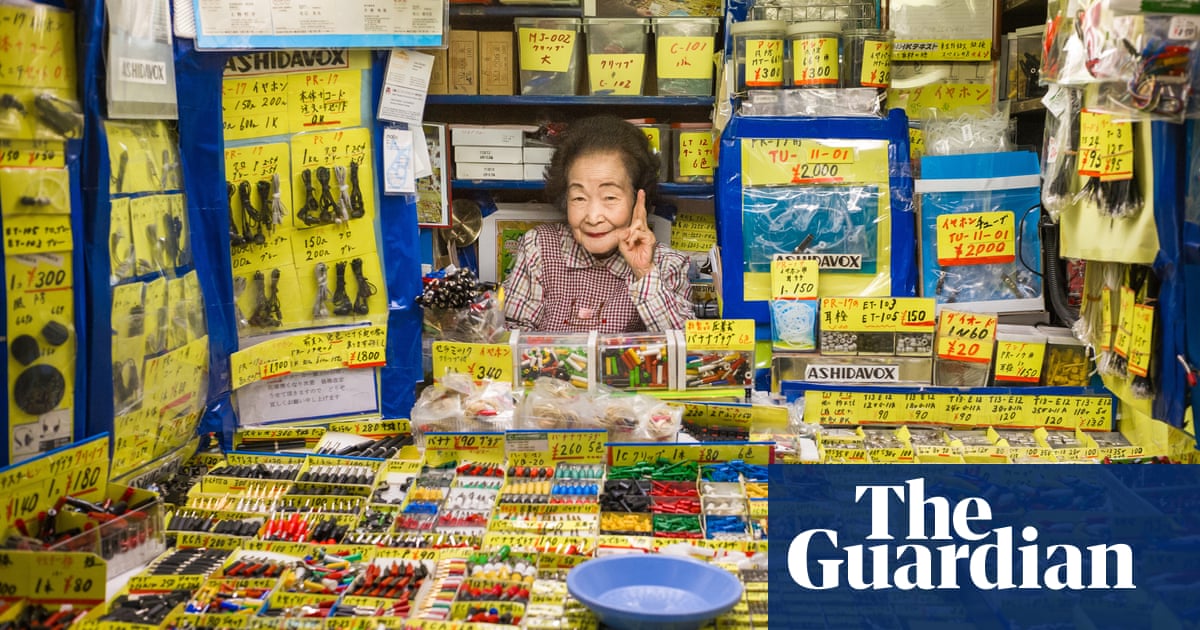In 1990, a young Japanese photographer named Kyoichi Tsuzuki began capturing a rarely seen view of domestic life in one of the world’s most densely populated cities. Over three years, he visited hundreds of Tokyo apartments, photographing the living spaces of friends, acquaintances and strangers. These images, published in Tokyo Style (1993), looked startlingly unlike the rarefied minimalism that the world had come to expect from Japan. Tsuzuki’s photos were a joyous declaration to the contrary, celebrating the vitality of living spaces filled with wall-to-wall clutter.
In the late-20th century, Japan was known for its minimalism: its zen arts, its tidy and ordered cities, its refined foods and fashions. But Tsuzuki peeled away this facade to reveal a more complicated side to his nation. And Tokyo was the perfect setting for this exfoliation. Like the interiors he photographed, it remains visually overwhelming – even cluttered. Outside, enormous animated advertisements compete for attention against a jigsaw puzzle of metal, glass, concrete and plastic. In the sprawling residential districts that radiate from the city centre, compact homes are packed in formations as dense as transistors on a semiconductor chip, while confusing geometries of power lines spiderweb the skies above.
In suburbs across the nation, homes filled to the rafters with hoarded junk are common enough to have an ironic idiom: gomi-yashiki (trash-mansions). And in areas where space is limited, cluttered residences and shops will often erupt, disgorging things on to the street in a semi-controlled jumble so ubiquitous that urban planners have a name for it: afuré-dashi (spilling-outs). This is an ecstatic, emergent complexity, born less from planning than from organic growth, from the inevitable chaos of lives being lived.
Tsuzuki dismissed the west’s obsession with Japanese minimalism as “some Japanophile’s dream” in the introduction to the English translation of Tokyo: A Certain Style (1999). “Our lifestyles are a lot more ordinary,” he explained. “We live in cosy wood-framed apartments or mini-condos crammed to the gills with things.” Yet more than 25 years after Tsuzuki tried to wake the dreaming Japanophile, the outside world still worships Japan for its supposed simplicity, minimalism and restraint. You can see it in the global spread of meticulously curated Japanese cuisine, the deliberately unadorned concrete of modernist architects like Tadao Ando, and even through minimalist brands like Muji – whose very name translates to “the absence of a brand” in English.
Millions around the world continue to turn to Japanese gurus for help in purging their diets, closets and living spaces of all but the most essential items. Books like Marie Kondo’s The Life-Changing Magic of Tidying Up: The Japanese Art of Decluttering and Organizing (2011) and Fumio Sasaki’s Goodbye, Things: The New Japanese Minimalism (2015) reframe clutter as a dire threat to mental health and spiritual growth. They have become colossal hits in the United States and other countries. However, as the world turns to Japan to tidy up, it’s important to remember that these books were originally intended for Japanese readers; they weren’t written for the world outside. If Japan truly were a minimalist paradise, why would it need Kondos and Sasakis in the first place?
Japan, then, isn’t really a paragon of refined simplicity. But if clutter is such an important part of everyday life here, why is it so often overlooked? The story of the world’s fascination with Japanese stuff is in many ways not about Japan at all. It is the story of our own changing desires, our social anxieties, our urges to consume and accumulate, and our realisation that possessing more things doesn’t necessarily translate into more happiness. In Japan, we believe we have found solutions to our problems.
The grass may seem neater on the other side, but Japan’s clutter tells a different story. It’s one that reveals a far more complex and nuanced relationship with stuff, one that suggests minimalism and clutter aren’t opposites, but two sides of the same coin. For the country of Japan is filled with spaces that are as meticulously cluttered as minimalist ones are meticulously simplified. These packed places, which are every bit as charming as the emptied ones, force us to question our assumptions and worldviews. What if we’ve all been wrong about clutter?
The foreign obsession with Japan’s material culture began soon after the opening of the nation’s ports in 1853. Though the country remained difficult to visit in person, the opening allowed a burgeoning Pacific trade to bring Japanese wares to the citizens of the world by the literal boatload. Europeans and Americans quickly noticed that there was something different about things made in Japan. There were “strange caprices in their ornamentation which, though violating our hitherto recognised proprieties of decoration, surprised and yet delighted us”, as the US archaeologist Edward S Morse put it in Japanese Homes and Their Surroundings (1885).
Exports of exquisitely decorated ceramics, textiles, metal arts, furniture, jewellery and art prints sparked a European movement that the French called Japonisme. On the other side of the Atlantic, a Japan craze seized American tastemakers. The Victorian fad for all things Japanese profoundly affected western ideas of civilisation and sophistication, shifting the course of art and architecture, culture and society. The ripple effects of this sea change in tastes can still be felt today. The popularity of the impressionists; the architecture of Frank Lloyd Wright and the bungalows of the Arts and Crafts movement; even fashion arbiters such as Hermès and Louis Vuitton: all rose to prominence through their interpretations of Japanese styles. Charles Tiffany, the founder of Tiffany & Co, adorned his western-style tableware, jewellery and furnishings with motifs inspired by Hokusai and other artists, going so far as to declare his firm’s sensibilities “even more Japanese than the Japanese themselves”.
This story of the western world’s obsession with Japan during the 19th century is well known. Often overlooked, however, is the fact that, at the same time, the western world possessed an equal or even greater fascination with the absence of Japanese stuff. In 1863, Great Britain’s first ambassador to Japan, Rutherford Alcock, noted the “great love of order and cleanliness” during his stay. But what really threw him was the lack of superfluous furnishings or decorations in the many places he stayed: “There is something to admire,” he wrote, “in this Spartan simplicity of habits, which seems to extend through all their life, and they pride themselves upon it.”
To the Japanese, there was nothing unusual about their empty rooms. Who needs chairs when you can sit on the floor? Why leave futons out when they can be folded up and put away each morning? Why wouldn’t an unused room be empty? Yet, into that void, early western visitors projected their insecurities about their own societies. Alcock saw the “universal absence of luxury” as a kind of transcendence, reading into it a liberation from the materialistic rat-race of western consumerism.
Few foreign observers at the time possessed the cultural insight to analyse Japan’s style of home decor in context. One of them was Morse, who in 1885 fumed that most critics “do not regard such matters from a Japanese standpoint”. For Morse, the lack of stuff was less a product of aesthetics than of economics. He was frustrated that other critics had failed to consider “that the nation is poor, and that the masses are in poverty”.
By turns reverential and condescending, ideas of Japan’s enlightened design sensibilities swept western society. In 1882, the Vanderbilts installed an ostentatious Japanese parlour at the family’s Triple Palace on Fifth Avenue in New York City. This Anglo-Japanified aesthetic quickly percolated from the gentry to society at large. At the St Louis World’s Fair in 1904, replicas of Japanese living spaces attracted raves from visitors, one of whom exclaimed: “No housewife should omit seeing [them] … Simplicity and perfect taste mark them in every detail. No stuffing of rooms with crudely designed and unnecessary furniture!”
Japan’s slide into fascism and war in the early 20th century snuffed out the world’s fascination with all things Japanese. After the end of the second world war, the fascination rekindled, and history began to repeat. Japan was poor once again. In the 1950s, American beatniks rediscovered Japanese minimalism, interpreting the Buddhist zen teachings of DT Suzuki as an antidote to “square” society’s out-of-control consumerism. Just as it had in the late 19th century, this view of Japanese minimalism and simplicity filtered from early adopting coolfinders into the mainstream. When the Museum of Modern Art erected a traditional Japanese home in its sculpture garden in 1954, the structure’s austerity left a deep impression on New Yorkers. “Let those who wish to live in their cluttered Sears, Roebuck modern and atrocious bad taste we see so often,” wrote an aficionado to the New York Times that year. “I’ll take the uncluttered.”
Seventy years have passed, and yet the world’s obsession with Japanese simplicity is, if anything, reaching all-new heights. More than ever, people feel the need to take charge of their lives. And what better place to start than our domestic spaces? When everything feels chaotic and unpredictable, we can assert a modicum of control by tidying our homes. This is how Japanese minimalism began to morph from a spirit-quest into yet another commodity: a packaged form of self-improvement.
The world still turns to Japan for things; it also turns to Japan to rid itself of them. There’s only one problem: Japan isn’t anywhere near as tidy as outside observers give it credit for.
It makes sense that Japan was misunderstood by outsiders in the 19th century, for foreigners never got much of a look into average Japanese homes. Alcock, who saw Japan’s absence of luxury as a virtue, and Morse, who saw it as a mark of poverty, were both wrong. Japan may not have industrialised as the west had in the 19th century, but its markets weren’t lacking in luxuries. Its major cities rivalled the size of the biggest foreign capitals, and were home to thriving consumer economies. Countless artisans toiled to deliver inessentials and entertainments to urbanites hungry for stimulation and escape. How else to explain the lightning speed with which sophisticated arts and crafts began flowing from Japan’s studios into the homes of the world after the nation opened its ports in 1853? The living spaces of average folks were undoubtedly chock-full of knick-knacks, playthings and adornments – but foreign visitors, who then mixed rarely with Japanese locals, almost never had the chance to see them.
This lack of access led to grand generalisations about the country, where westerners celebrated Japan’s “austerity” and “minimalism” even as we hungrily consumed the vast array of luxuries Japanese produced for themselves – and, once they realised the foreign demand, specifically for export.
The same pattern can be seen in the 20th century. In the decades after the second world war, Japan was a far less popular tourist destination than it is now. During the heights of its “bubble economy”, which began in 1985, foreigners were still a rarity on Japanese streets, let alone in Japanese homes. So it should come as no surprise that they might have missed just how wildly materialistic Japanese society had grown during this time – or how cluttered its domestic spaces were becoming.
As Americans and Europeans fumed over invasions of their marketplaces, they ignored the fact that Japanese homes were filling with the same electronics and entertainments: Walkmans, karaoke machines, videocassette players, televisions, stereos, countless toys, video games, cartoons, comics and nearly every other packaged delight one might imagine, all tested on eager domestic consumers before being released to the world. In the late 1980s, consumerism was in such swing that households frequently tossed out almost-new appliances and electronics, to make room for the newest models with their incremental improvements. In the early 1990s, when I was in Tokyo as a foreign student, I would eagerly await these bulk garbage days, when I might scout for a perfectly operational television or turntable – an American scavenging Japan’s discards, in a strange, ironic echo of the Japanese who sifted through the refuse of US bases after the war.
The fervour with which Japanese people consumed and discarded during the economic bubble was a testament to how wealthy the average citizen felt at the time. But when the bubble burst in 1990 and the economy stagnated, people began to re-evaluate their relationship with all the things they’d bought. They had surrounded themselves with stuff – and where had it got them? A reckoning was on the horizon, a grand decluttering. You’d be forgiven for thinking it a product of this particular moment in history. But herein lies another surprise: this wasn’t the first time Japan had come to grips with having too much stuff.
The Engishiki, a handbook from 927, laid out detailed instructions for cleaning the imperial palace of Kyoto every year. In the centuries to come, Buddhist temples and Shinto shrines followed suit and, by the 17th century, an annual year-end tidying-up emerged as a popular ritual among the masses, in the form of the ōhsōji: a “big cleaning” to ring in the New Year.
In the 1990s, the “lost decade” after the economic crash, this tradition morphed into a different form, as Japan wrestled with the conundrum of being a consumer-manufacturing powerhouse whose citizens were growing increasingly ambivalent about buying things. The products that once symbolised an ascent out of poverty, the stuff with which people had eagerly surrounded themselves just a few years before, now seemed the symptom of an out-of-control age, a fever dream of consumption. Getting rid of this stuff felt necessary, even imperative. But how?
A series of cleaning gurus had the answers. They reframed clutter from a tedious chore to be tackled into a sort of calamity that had befallen us. Along the way, they transformed the humble clean-up into a new form of holistic therapy, turning trash into transcendence – and global riches.
Only a few years after Japan reopened its ports to the world, the British author Samuel Smiles published Self-Help; With Illustrations of Character and Conduct (1859), which compiled the stories of successful artists, educators, missionaries and captains of industry. A Japanese translation in 1871 proved so popular that customers queued outside booksellers overnight to make sure they could get their hands on the treatise. It would go on to sell more than a million copies in Japan, making it one of the bestselling books in the country during the 19th century.
It wasn’t until 2000 that someone crossed the concept of the self-help book with Japan’s domestic cleaning tradition. By this time, it was obvious that the conditions of the lost decade had become the new normal. The nation’s vaunted lifetime employment system well and truly collapsed. New hiring plunged. Depression rates soared. Citizens grew anxious and adrift. And clutter became a proxy for all that unease and ennui.
The first answer to the question of clutter arrived with the turn of the millennium, when the magazine editor turned freelance writer Nagisa Tatsumi scored a megahit with Suteru! Gijutsu (2000) (The Art of Discarding), which proposed “a positive attitude” to getting rid of things. Tatsumi targeted single young women, a new and rapidly growing Japanese demographic, the result of plunging marriage and birthrates that upended traditional ideas of family, career and even adulthood.
Next came Hideko Yamashita, a housewife whose book Shin Katazukejutsu Danshari (A New Cleaning Method: Danshari) rocketed up Japanese bestseller charts in 2009. She borrowed the neologism danshari from a yoga term for the renunciation of worldly attachments. Written with the kanji-characters for “refusal”, “separation” and “disposal”, it became the perfect stand-in for the war on stuff.
All of this paved the way for Marie Kondo, whose Jinsei wo Tokimeku Katazuke no Maho (Tidying Magic to Make Your Life Shine) arrived in 2011. She singled out Tatsumi by name in the first chapter, and unabashedly wove Shinto spiritual traditions into her method. The English translation, retitled The Life-Changing Magic of Tidying Up: The Japanese Art of Decluttering and Organizing (2014), came out in the US three years later. The subtitle is telling: now decluttering was no longer a form of housework but an Art, with a capital A, echoing austere pastimes such as inkbrush-painting or the tea ceremony.
Neither of Kondo’s predecessors had been published in translation at that point, so her Japanese take on tidying hit foreign readers like a bolt out of the blue. Kondo owed her success to hard work, but also to excellent timing, for the US was beginning to resemble Japan as a postindustrial society. After the 2008 financial crisis, Americans experienced that same sense of precarity and unease that paved the way for the tidying boom in Japan after its own crash. Decluttering appealed to those who felt their agency had been stripped from them. If you couldn’t reorganise society, the thinking seems to have gone, at least you could reorganise your cupboards.
There was just one issue. In the hyperconsumer societies of Japan and the west, minimalism is extraordinarily difficult to achieve, let alone maintain over the long term. If it were easy, we wouldn’t regard gurus like Kondo with such awe, nor would we be moved by the austerity of zen temples or Shinto shrines. They exist as a counterpoint to our mundane lives. And think back to Tsuzuki’s pictures of Tokyo homes. They hinted, even insisted, that a life surrounded by stuff wasn’t unusual or pathological. It could be invigorating, even nourishing. If the people in Tsuzuki’s anti-tidying manifesto could make it work, was clutter really the problem?
It has been two decades since Japan’s tidying boom began, and the nation remains as cluttered as ever. I know this because I live here. I have seen it with my own eyes, in the cities and countryside, in businesses and residences. I see it in my own home in Tokyo, typing these words from a room in which stuff relentlessly accumulates no matter how many times I clean up. Yet I don’t feel oppressed by my clutter, because it is clutter with which I have chosen to surround myself. My clutter is me.
I love the elegant simplicity of Buddhist gardens and Shinto shrines, of the tea ceremony and kaiseki cuisine. I love austere modernist architecture and product design. Yet these things have always struck me more as virtual constructs than realities. They are to be experienced in brief sojourns rather than to be lived in, like bathing in otherworldliness before returning to the humdrum reality of one’s ordinary life. But there is something powerful that happens when we focus on the “ordinary”. Clutter for its own sake is not a virtue. I’m not defending the filthy or garbage-strewn. I am not embracing the unhygienic or unhinged. I’m talking about a very specific type of clutter: a cultivated sort of clutter.
There’s a perfect example of this in the leafy western suburbs of Tokyo, home to one of the city’s most popular attractions: the museum of the famed anime production company Studio Ghibli, creator of globally acclaimed films including Spirited Away (2001) and The Boy and the Heron (2023). Inside the immaculately designed and managed facility is a replica of the director Hayao Miyazaki’s workspace. It is a glorious mess. Heirloom-grade wooden shelves, overflowing with bric-a-brac and thick tomes, line the walls. The focal point of the space is a sturdy antique desk, piled with references and feathered with sticky notes, jars of pens, brushes and paints at the ready for capturing some new flight of fancy. On the opposite side is a worktable piled with sheafs of paper, tools and a model airship under construction. More model aircraft hang from the ceiling and walls, alongside tacked-up reference photos of vintage cars, buildings and planes. Stained-glass windows bathe the room’s curios in warm light; a basket of kindling sits ready to feed an old potbelly stove. Here and there sit empty bottles of wine, the remnants, perhaps, of late-night brainstorming sessions.
In Miyazaki’s reconstructed workspace, even the dust motes swirling in the sunlight feel artisanal. But like so many Studio Ghibli films, this fantasy germinated from a kernel of reality. Miyazaki really did intend to spend a few days every month working here, on that comfortable and expensive-looking wooden swivel chair, as a sort of gift to fans. The first time he tried it, though, gawkers so clogged foot-traffic through the museum that he was forced to abandon the idea.
Visually dense scenes of clutter are some of the most striking moments in Miyazaki’s films. Scenes like Howl’s overflowing bedroom in Howl’s Moving Castle (2004) or the chaotically heaped tables of food in Spirited Away make them Miyazaki films. And Miyazaki knows this, which is likely why he felt compelled to build a simulacrum of disorder in the middle of a meticulously ordered museum.
Like Miyazaki’s office, the best clutter is a byproduct of taste and time, accrued and overlaid as a space is lived in and used, as the owner acquires more objects of their peculiar fancies and proclivities. This kind of clutter proliferates in Japan and is, at its best, sublime.
You can find it in the homes that Tsuzuki shot. You can find it in businesses like Gojira-ya, an antique toy store I sometimes visit in the Tokyo neighbourhood of Koenji, where every inch of wall space and even ceiling is brimming with ephemera. (This store is in fact what first sparked my interest in clutter.) You can find it in restaurants, bars and workspaces. While treatises abound on Japanese simplicity, minimalist design and culture, precious little is written about the nation’s masterfully messy side. Japan’s philosophy of aesthetic accumulation is mostly unacknowledged but there are some who have attempted to celebrate the other side of simplicity.
I met the author of Tokyo Style in a Tokyo cafe on a crisp spring afternoon. Kyoichi Tsuzuki sat beside a window that looked out over an intersection almost as crammed as the apartments in his book. I asked what drew him to defy the conventional image of Japan as a minimalist wonderland.
“Cluttered spaces reflect the lifestyles of their occupants,” Tsuzuki told me. “Minimalism, on the other hand, is a way of establishing privacy. You can’t tell what that person wears or eats.
“Clutter isn’t really an east versus west thing,” continued Tsuzuki. “It’s a rich versus poor thing. Wherever you go, anywhere in the world, the wealthy have the luxury of living in clean, minimal spaces, while the poor have to make do with small, cramped ones, without any way to hide their belongings.”
He continued: “Consider the teahouse, which so many foreign people associate with Japanese minimalism. It’s a small space with nothing inside, right? But you need to have the space to build a teahouse. You need money to build one. A minimalist space is something only those with space and money can create.”
Tellingly, many of the things intimately associated with Japanese minimalism – such as rock gardens, temples, Noh stage plays, or the zen arts of inkbrush painting or flower arrangement – were once the near-exclusive bailiwick of society’s elite. Many of the foreigners who visited Japan in the 19th century encountered the simplicity of this elite world. For Alcock, writing during his time as the British ambassador, the “Arcadian simplicity” in Japan contrasted with the “ostentatious entertainments” that were the source of “misery” in the west. Japanese simplicity represented the antithesis of the west’s industrialised complexity – and embodied philosophical ideals that the west could study and emulate. But Alcock never thought to ask whether the Japanese saw things in such a polarised way.
In his 2016 book Nihon to Iu Hoho (The Method Called Japan), the cultural critic Seigow Matsuoka explored a similar idea when he described Japan’s approach to curating its culture in terms of “subtractive” and “additive” philosophies. Subtractive, he writes, “gives us the style of arts defined by their reductiveness, such as teahouses or zen gardens, Noh plays and buyō dancing, or even poetry such as waka and haiku.” These are status symbols for the upper crust. Meanwhile, additive gives us populist pleasures for everyone: “The gorgeously ostentatious stylings of matsuri festival floats, of the kabuki stage or Nikkō Tōshō-gū shrine.”
Subtractive is contemplative; additive is stimulating. But, above all, the Japanese are master editors, he says, picking and choosing between polar opposites to suit the occasion. This is why Japanese people continue to remove their shoes indoors, even as they choose to live in western-style houses. It’s why they continue to distinguish between Japanese-style and western-style foods, hotels, even toilets. To Matsuoka, the subtractive and additive approaches aren’t inherently in opposition; the distinction is simply a matter of context. But, over the past century, one approach seems to have attracted more attention from outsiders.
Part of the reason why subtractive minimalism may seem more significant than additive clutter is because the former has been associated with spirituality – with Shinto and Buddhism in particular. But Matsuoka hints that clutter may have a spiritual home as well. He believes it is perhaps most evident in Nikkō Tōshō-gū, a Shinto shrine around two hours north of downtown Tokyo that is the final resting place of Tokugawa Ieyasu, who unified Japan in 1600 and was appointed shogun in 1603. Shinto shrines are more generally known for their rustic charm. Many are built with unpainted wood, for instance, with few adornments. But Tōshō-gū is the polar opposite. Elaborate carvings of plants, animals and heroes cover virtually every surface, painted in every colour of the rainbow, all of it accentuated with hundreds of thousands of sheets of gold leaf. This seems to have been intended as a visual representation of Ieyasu’s awesomeness but, to the uninitiated, it can come across as gaudy. “Barbaric overloaded baroque,” fumed the German architect Bruno Taut after his visit in 1937. He called it “the historical source of Japanese trash”.
Contrast this impression with a famed Japanese idiom: “Don’t say kekko [perfect] until you’ve seen Nikkō.” To many, Nikkō’s ultradecoration is transcendent, its decor intended to evoke shock and awe in the same way that the leader enshrined within once did. How is it that the same culture that reveres minimalism also delights in maximalism, too? Often, austerity and clutter are posed in stark opposition to one another. But the subtractive and additive are deeply entwined in Japan, locked in a cultural conversation that has been unfolding since time immemorial, sweeping back and forth like the tides. And like the tides, they cannot exist alone, only in comparison with one another. Clutter and tidiness are not in opposition. They create each other.
Even places hailed for their minimalism reveal this. Buddhist temples and Shinto shrines are widely viewed as some of Japan’s most contemplative spaces. Yet, once a year or so, many throw a matsuri festival, fielding parade floats that share more in common with Tōshō-gū’s glamour and excess than the quiet austerity of the average shrine. These floats take many forms, but even the humblest are covered with gleaming metal fittings, often topped with a glorious gilt phoenix, and carried about by large groups with the aid of rhythmic shouts and more than a little saké. Festivals are also inevitably marked by temporary shopping arcades offering traditional fast foods and opportunities to win toys in games of chance, advertised with wildly colourful signage and banners. Matsuri offer both an opportunity to show spiritual gratitude and for communities to come together and let off steam.
But just like the gaudy Tōshō-gū, frenetic festivals show that an additive, stimulating cultural moment might possess just as much spiritual power as a subtractive, contemplative one. The world – but especially the western world – has long sought out the extremes in Asian cultures, as explored by the Palestinian American philosopher Edward Said in his pioneering book Orientalism (1978). Said was the first to point out how this inevitably came at the expense of the Orient, which was othered and minimised in comparison with the “normal” west. The fascination with Japanese minimalism is almost worshipful, but no less reductive.
Minimalist spaces are designed to focus and inspire, then send us on our merry way. Carefully cluttered spaces draw us in, whether in creating a welcoming atmosphere for customers, a stimulating one for collectors, or a creative one for craftspeople.
If minimal spaces quietly telegraph the virtues of their creators, so do the best clutter-spaces, in different ways.
The world has long turned to Japan for inspiration in simplifying their lives. The Victorians projected upon Japanese arts and crafts values they believed the west had lost in its march towards industrialisation. The Beats sought nirvana in the Buddhist philosophy of D T Suzuki. Tech bros restyle themselves as techno-ascetics in a minimalist trend that the writer Kyle Chayka in 2016 called “Silicon Valley’s version of zen monkhood”. And people everywhere have tried to regain control of their lives by applying Kondo’s shinto-inflected KonMari Method™. The idea that Japan possesses answers to the problems of overconsumption is a siren song whose volume varies over the decades but never goes away.
Yet as Japan provides a roadmap to simplicity, it also gives us a vision of clutter. The nation may or may not possess the magic of tidying up, but its untidy spaces can be magical in their own rights. There is a dreary sameness to so much of modern culture, rough edges smoothed into comfortable averages by the power of market research and algorithms. It’s why the movies we watch are sequels of sequels, or the music we listen to feels like samples of samples, or the fashions we wear turn out to be copies of copies.
Cosily curated Japanese clutter-spaces are different. There is a meticulousness to the best of them that is on a par with the mental effort poured into simplifying something: a deliberate aesthetic decision to add, rather than subtract – sometimes mindfully, sometimes unconsciously, but always, always individually. Clutter offers an antidote to the stupefying standardisation of so much of modern life.
Before Tsuzuki and I parted ways, I asked him if he had any thoughts of producing a follow-up to Tokyo Style. But 30 years later, times have changed. “Today, the idea that you’ll hold on to a lot of things for your whole life is fading,” said Tsuzuki. “Take clothing. It used to be the case that good clothes cost a lot. You’d buy them and take care of them and wear for years. So you’d naturally build up a collection. But now we’re surrounded by low-cost retailers that are just good enough. You wear it for a season and that’s it.”
For Tsuzuki, “just good enough” means a world of disposable things. Few of the items around us are treasured. When younger Japanese grow tired of the things they own, he says they tend to set them free rather than tossing them away, using online auctions or consumer-to-consumer transaction sites. The result, he thinks, is that we will “have less things”. This seems counterintuitive: don’t developments like fast fashion, big-box stores and online shopping fuel our instincts to consume even more? But the ephemeral nature of these items means we don’t care about them as much. In the late 19th century, when Morse attempted to explain why people in Japan occupied “dwellings of the simplest character”, he made a different argument. Simplicity had emerged, he believed, because the nation’s citizens were “poor in every sense of the word”. But Tsuzuki upends this. No, he says, simplicity isn’t about poverty at all. It’s about wealth. And simplicity is now trickling down to the masses, thanks to revolutions in cheap globalised labour, logistics and technology.
It is as though the concepts of minimalism and clutter are inevitably fusing into a singularity: when disposability or recyclability is built into the act of acquisition, the very idea of accumulation falls to the wayside. And this process is only accelerating as more and more of our lives – especially our shopping – takes place in virtual online spaces. Acquisition itself also changes meaning, as things we purchase come in the form of data rather than goods: today, we often borrow and share rather than physically own. The struggle between clutter and clean has been unfolding in Japan for centuries but, if current trends continue, the battle may soon be moot.
Even so, I suspect Japan will never truly divest itself of its clutter-spaces, for clutter and clean are eternally linked, one meaningless without the context of the other. For how could we clean without having a mess to motivate us? And this makes perfect sense when you think about it: if Japanese people really lived in minimalist temples, why did they need someone like Kondo to teach them the magic of tidying up? The world loves the idea of Japan as a minimalist paradise, but carefully curated clutter shows us that more can be every bit as meaningful as less. And in a world of obsolescence and homogenised sameness, well-cluttered spaces feel like a declaration of liberation. They can be oases of humanity, as messy and unpredictable and creative and real as we are. They are ordinary. But so are we.
This essay first appeared under the title The Joy of Clutter on Aeon.co.













